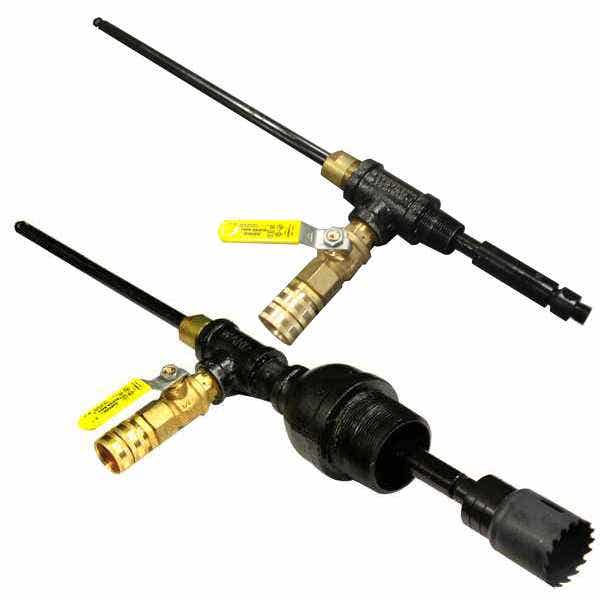Hot Tapper, Single Size 261 Series
Single Size Hot Tappers include:
- Tapper Body
- NPT Adapter
- Arbor
- Pilot Drill
- Coupon Retainer Wire
- Hole Saw
For hole saw speeds, Click Here.

| Image | Press. Pipeline Max | Description | Shipping Wt. | Item Number | Price | Qty | Action |
|---|---|---|---|---|---|---|---|

|
100 psi (6.89 bar) | Hot Tapper, 6" NPT X 5-3/4" Carbide Hole Saw | 29 Lb (13.15 Kg) | 261-0060-C |
$1,300.00
|
||

|
100 psi (6.89 bar) | Hot Tapper, 6" NPT X 5-1/2" Bi-Metal Hole Saw | 29 Lb (13.15 Kg) | 261-0060- |
$1,130.00
|
||

|
100 psi (6.89 bar) | Hot Tapper, 5" NPT X 4-3/4" Carbide Hole Saw | 29 Lb (13.15 Kg) | 261-0050-C |
$1,120.00
|
||

|
100 psi (6.89 bar) | Hot Tapper, 5" NPT X 4-3/4" Bi-Metal Hole Saw | 29 Lb (13.15 Kg) | 261-0050- |
$971.00
|
||

|
100 psi (6.89 bar) | Hot Tapper, 4" NPT X 3-7/8" Carbide Hole Saw | 13 Lb (5.90 Kg) | 261-0040-C |
$869.00
|
||

|
100 psi (6.89 bar) | Hot Tapper, 4" NPT X 3-7/8" Bi-Metal Hole Saw | 13 Lb (5.90 Kg) | 261-0040- |
$756.00
|
||

|
100 psi (6.89 bar) | Hot Tapper, 3-1/2" NPT X 3-3/8" Carbide Hole Saw | 13 Lb (5.90 Kg) | 261-0035-C |
$823.00
|
||

|
100 psi (6.89 bar) | Hot Tapper, 3-1/2" NPT X 3-3/8" Bi-Metal Hole Saw | 13 Lb (5.90 Kg) | 261-0035- |
$715.00
|
||

|
100 psi (6.89 bar) | Hot Tapper, 3" NPT X 2-7/8" Carbide Hole Saw | 10 Lb (4.54 Kg) | 261-0030-C |
$771.00
|
||

|
100 psi (6.89 bar) | Hot Tapper, 3" NPT X 2-3/4" Bi-Metal Hole Saw | 10 Lb (4.54 Kg) | 261-0030-1 |
$703.00
|
||

|
100 psi (6.89 bar) | Hot Tapper, 3" NPT X 2-7/8" Bi-Metal Hole Saw | 10 Lb (4.54 Kg) | 261-0030- |
$670.00
|
||

|
100 psi (6.89 bar) | Hot Tapper, 2-1/2" NPT X 2-3/8" Carbide Hole Saw | 8 Lb (3.63 Kg) | 261-0025-C |
$727.00
|
||

|
100 psi (6.89 bar) | Hot Tapper, 2-1/2" NPT X 2-3/8" Bi-Metal Hole Saw | 8 Lb (3.63 Kg) | 261-0025- |
$631.00
|
||

|
100 psi (6.89 bar) | Hot Tapper, 2" NPT X 1-7/8" Carbide Hole Saw | 6 Lb (2.72 Kg) | 261-0020-C |
$624.00
|
||

|
100 psi (6.89 bar) | Hot Tapper, 2" NPT X 1-7/8" Bi-Metal Hole Saw | 6 Lb (2.72 Kg) | 261-0020- |
$543.00
|
||

|
100 psi (6.89 bar) | Hot Tapper, 1-1/2" NPT X 1-3/8" Carbide Hole Saw | 5 Lb (2.27 Kg) | 261-0015-C |
$595.00
|
||

|
100 psi (6.89 bar) | Hot Tapper, 1-1/2" NPT X 1-3/8" bi-Metal Hole Saw | 5 Lb (2.27 Kg) | 261-0015- |
$517.00
|
||

|
100 psi (6.89 bar) | Hot Tapper, 1-1/4" NPT X 1-1/8" Carbide Hole Saw | 5 Lb (2.27 Kg) | 261-0012-C |
$565.00
|
||

|
100 psi (6.89 bar) | Hot Tapper, 1-1/4" NPT X 1-1/8" Bi-Metal Hole Saw | 5 Lb (2.27 Kg) | 261-0012- |
$492.00
|
||

|
100 psi (6.89 bar) | Hot Tapper, 1" NPT X 7/8" Carbide Hole Saw | 5 Lb (2.27 Kg) | 261-0010-C |
$536.00
|
||

|
100 psi (6.89 bar) | Hot Tapper, 1" NPT X 7/8" Bi-Metal Hole Saw | 5 Lb (2.27 Kg) | 261-0010- |
$465.00
|
||

|
100 psi (6.89 bar) | Hot Tapper, 3/4" NPT x 5/8" Carbide Hole Saw | 4 Lb (1.81 Kg) | 261-0007-C |
$504.00
|
||

|
100 psi (6.89 bar) | Hot Tapper, 3/4" NPT X 5/8" Bi-Metal Hole Saw | 4 Lb (1.81 Kg) | 261-0007- |
$438.00
|
||

|
100 psi (6.89 bar) | Hot Tapper, 1/2" Single Size | 4 Lb (1.81 Kg) | 261-0005- |
$410.00
|
Types of Hot Tappers Offered by Petersen Products
At Petersen Products, has a variety of hot tappers, which produce hot tap holes up to 6" in diameter.
- Mechanical Hot Tappers: These hot tappers are designed for manual operations, making them a preferred choice for routine maintenance and emergency innervations. They feature components, such as a head, pilot drill, and drive mechanism, which work together to make a safe cut into the pipe while maintaining pressure containment. Known for their simplicity, reliability, and ease of use, these hot tappers allow operators to perform modifications and repairs with minimal disruption.
- Pneumatic Hot Tappers: Pneumatic hot tappers feature a pneumatically driven motor, pilot drill, and cutting head. These tools ensure safe penetration while maintaining system pressure. These advanced tools use compressed air to power cutting and drilling operations on live pipelines or vessels. Compared to manual methods, they offer higher precision, efficiency, and controlled cuts, making them ideal for large-scale industrial applications. Pneumatic power also reduces operator strain and enhances safety, making these tappers preferred for critical hot tapping operations.
Benefits of Hot Tapping
Hot tapping offers various advantages, especially to industries like oil and gas, chemicals, and water, where continuous operation is paramount.
- Continuous Operation: One of the most significant advantages of the hot tapping technique is that it allows modifications, maintenance, or new connections to be made without shutting down the system. This is valuable in processes where downtime can be costly or disruptive.
- Safety: Hot tapping is a safe process when performed correctly. The specialized equipment and procedures help minimize risks to personnel and the environment, even when working on high-pressure or hazardous pipelines.
- Flexibility: Hot tapping can be performed on pipes made of different materials, including steel, iron, and plastic. It can also be performed on both pressurized and non-pressurized systems. The technique allows multiple connection points on a single pipeline without disrupting the flow.
- Efficiency: Hot tapping is significantly more efficient than traditional methods. It allows operators to perform the procedure without disrupting the flow within the pipeline. The equipment used in hot tapping is designed to create a new connection or perform necessary modifications directly on a live pipeline, eliminating the need for draining and purging. This streamlined approach not only saves time but also reduces the complexity of the operation.
- Environmental Benefits: Hot tapping significantly reduces the environmental impact of maintenance and modification activities by eliminating the need to depressurize or empty pipelines. Hot tapping, however, allows for modifications and connections to be made while the pipeline remains fully pressurized and operational. This approach minimizes the release of emissions, as there is no need to vent gases or other substances into the environment. Furthermore, because the pipeline contents are not drained, the generation of waste materials is significantly reduced.
- Cost-effectiveness: As the system remains operational, the cost required for shutting down and restarting operations is avoided. This results in significant savings, mainly in large-scale industrial operations. Keeping the system running minimizes production losses typically during a shutdown.
Applications of Hot Tapping Machines
Our hot tapping machines find uses across industries. Here are some of them:
- Refineries: Hot tapping allows for expanding process lines or adding new units without shutting down the entire facility, avoiding costly and time-consuming disruptions. This method enables regular maintenance and upgrades on essential lines, such as those carrying crude oil or refined products, while keeping the refinery fully operational.
- Mining: Hot tapping in mining allows for pipeline modifications, such as those carrying slurry, tailings, or managing water systems, without interrupting the material flow, ensuring continuous operations.
- Power Generation: Hot tapping is largely used in power plants. This technique can modify steam lines, cooling circuits, and other critical systems without disruption. It also facilitates the addition of monitoring points or instruments on live systems, ensuring uninterrupted data collection.
- Food and Beverage: Hot tapping modifies sanitary piping systems without contaminating the product or halting production. It also easily integrates new product lines or process improvements.
- Oil and Gas Industry: Hot tapping enables repairs, maintenance, and modifications on pipelines carrying oil, natural gas, or other hydrocarbons without system shutdowns. It also allows for installing sensors on live pipelines to monitor pressure, temperature, or flow.
- Water Distribution Systems: Municipalities and water utilities commonly use hot tapping to add new service connections or repair sections of water mains without disrupting the overall water supply.
Hot Tapping Equipment: Maintenance and Safety Guidelines
To ensure seamless and safe operations, the maintenance and safety of hot tapping equipment are paramount. Here are some important guidelines for maintaining hot tapping equipment, and ensuring safety during the process.
Maintenance Tips:
- Periodically inspect hot tapping equipment for wear, corrosion, or damage, and perform routine functionality tests on mechanical components. Ensure all moving parts are well-lubricated to prevent wear.
- Calibrate pressure gauges and sensors for accuracy. Keep cutting tools sharp and properly aligned to prevent equipment failure.
- Store hot tapping equipment in a clean, dry environment to prevent contamination and corrosion. Use proper shelving to protect components from dust and damage.
Safety Guidelines:
- Conduct a thorough risk assessment and obtain necessary permits (PTW) before starting hot tapping. Verify pipeline isolation to prevent unintended flow or pressure.
- Ensure all personnel wear appropriate PPE, including flame-resistant clothing, gloves, helmets, safety glasses, and hearing protection. Use respiratory protection in environments with hazardous gases.
- Monitor pipeline pressure and temperature during hot tapping. Ensure the work area is clear and equipped with emergency tools, and maintain proper venting to prevent gas accumulation.
- After hot tapping, secure the area, inspect the weld with non-destructive testing (NDT), and document the process, including any issues and resolutions for future reference.
- Ensure only trained and certified personnel perform hot tapping, with ongoing training and emergency response preparation for handling potential leaks, fires, or explosions.
- Ensure compliance with industry standards (ASME, OSHA, etc.) and conduct regular safety audits to maintain regulation adherence.
Petersen Products offers a wide array of hot tappers that are economical and easy to use. Depending on your requirements, purchase an individual-size hot tapper. Call or contact our experts, who will assist you with hot-tapping requirements.
Frequently Asked Questions and Answers on Hot Tappers
- What potential risks are involved in hot tapping?
Pressure release, fire, leaks, and explosions are the main risks associated with hot tapping. However, these risks can be mitigated through mindful planning, continuous monitoring, emergency preparedness, and more. - What is the usual duration of a hot tapping operation?
The tapping duration depends on the job's complexity, the pipe's size, and other factors. Most hot tapping operations can be completed in a few hours to a day. - What is the maximum pipe size that can be hot tapped?
The maximum pipe size that can be hot tapped depends on the specific project requirements and the capabilities of the hot tapping equipment. Our pneumatic and mechanical hot tappers can tap most hot water pipelines with 1/4" to 6" and 100 PSIG pressure.





